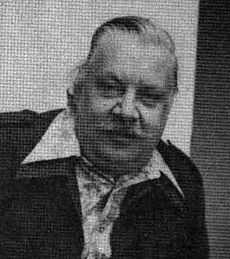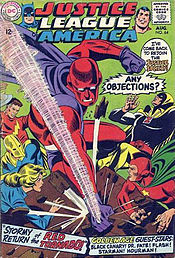- Dick Dillin
-
Dick Dillin 
Dick Dillin, from Amazing World of DC #11 (1976).Born Richard Allen Dillin
December 17, 1929
Watertown, New YorkDied March 1, 1980 (aged 50) Nationality American Area(s) Penciller Notable works Blackhawk
Justice League of America
World's Finest ComicsRichard Allen "Dick" Dillin (December 17, 1929, Watertown, New York, United States – March 1, 1980) was an American comic book artist best known for an extraordinarily long 12-year run as the penciler of the DC Comics superhero-team series Justice League of America. He drew 115 issues from 1968 up until his death, bridging the venerable title's Mike Sekowsky and George Pérez eras. DC Comics referred to Dillin as one of the "cornerstone talents" of the industry.[1]
Contents
Early life and career
Determined since childhood to draw for comics, Dillin graduated from Watertown High School to become an art student at Syracuse University on the GI Bill, following his military service with the 8th U.S. Army in Tokyo, Yokohama, and Okinawa. Sometime after marrying wife Estella in 1948, Dillin left his job at a Watertown manufacturer of air brakes for trains, and sought an art career in New York City. Six months later, after having done magazine illustration and other commercial art and gaining a foothold at Fawcett Comics and Fiction House, he relocated his family to suburban Peekskill, New York.
Dillin's art at Fawcett (on features including "Lance O'Casey" and "Ibis the Invincible" in Whiz Comics) and Fiction House ("Buzz Bennett", "Space Rangers") led to drawing for Quality Comics, beginning in 1952. He worked particularly on the popular title Blackhawk but also on G.I. Combat, Love Confessions, and Love Secrets. When Quality went out of business, Dillin, searching for new work, eventually tried DC Comics — where he saw one or more issues of Blackhawk on the desk as he was being interviewed, and to his relief was told, "We've been trying to get in touch with you." [2]
DC Comics
 Justice League of America #64 (Aug. 1968), penciller Dick Dillin's first issue. Inking by Joe Giella.
Justice League of America #64 (Aug. 1968), penciller Dick Dillin's first issue. Inking by Joe Giella.
Dillin returned to Blackhawk, now a DC property, and when the book's initial run ended, went on to draw issues of World's Finest Comics and Batman specials before being assigned Justice League of America, a superteam series featuring, at the time, Superman, Batman, Green Lantern, Wonder Woman, Green Arrow, and the Atom. Dillin penciled the series from #64-183 (Aug. 1968 - Oct. 1980), except for the planned reprint issues #67, 76, 85 and 93, issue #153 which was pencilled by George Tuska, and issue #157 where he provided the intro and epilogue pages while Juan Ortiz pencilled the main story. He had completed the first 2½ pages of #184 when he died; penciler George Pérez and inker Frank McLaughlin took over the title, starting that issue from scratch.
Dillin's tenure on JLA included the reintroduction of Red Tornado; the migration of the Black Canary from Earth-2 to Earth-1; the introduction of the JLA satellite; the 1973 and 1976 integration of the defunct and newly acquired Quality Comics and Fawcett Comics heroes, respectively; and the murder of the first Mr. Terrific, Terry Sloane.
Bibliography
Comics work (interior pencil art) includes:
DC
- Action Comics (Green Arrow) #424, 426, 431, 434, 436; (Atom): #425, 427, 430, 433, 435, 438-439, 448; (Private Life of Clark Kent): #477 (1973-77)
- Atom and Hawkman #40-45 (1968-69)
- Adventure Comics (Seven Soldiers of Victory): #438, 443 (1975-76)
- Batman #246 (with Irv Novick); (Robin): #252, 254 (1972-73)
- Blackhawk #108-241 (1957-68)
- Challengers of the Unknown #72 (1970)
- DC Comics Presents #7, 13-14, 18, 22, 25 (1979–80)
- DC Special Series (Aquaman): #1 (1977)
- DC Super-Stars #10 (1976)
- Detective Comics (Batman) #433, 483; (Hawkman): #428; (Green Arrow): #555 (1972-85)
- Flash (Kid Flash) #202, 204, 207, 209, 211, 216 (1970–72); (Green Lantern): #227-228, 230-231, 233-234, 245-246 (1974–77)
- Green Lantern, vol. 2, #67, 71 (1969)
- Hawkman #22-27 (1967–68)
- House of Mystery #197 (1971)
- House of Secrets #82, 84, 87-88, 92, 96 (1969–72)
- Justice League of America #64-66, 68-75, 77-84, 86-92, 94-152, 154-183 (1968–80)
- Spectre (Hourman) #7 (1968)
- Superman (Terra-Man): #249; (Fabulous World of Krypton): #257, 263, 266, 268 (1972–73)
- Unexpected #121-123, 126, 131, 133, 163, 165 (1970–75)
- Witching Hour #26 (1972)
- Wonder Woman #217 (1975) [3]
- World's Finest Comics (Superman team-ups): #198-205, 207-228, 231-233, 235-236, 238, 240, 257; (Green Arrow): #256 (1970–79)
Quality
- Blackhawk #37, 40, 64-65, 67-107 (1951-56)
- Plastic Man #45 (1954)
Other work
Dillin drew animation storyboards for the Trans-Lux/Joe Orolio syndicated TV series Johnny Zero (c. 1962), and The Mighty Hercules (1963), among other shows.[citation needed]
Footnotes
- ^ "Dick Dillin:1928–1980". The Comics Journal 1 (55): 15. April 1980. ISSN 0194-7869.
- ^ Alter Ego #30, Nov. 2003: Interview with the family of Dick Dillin
- ^ Per Amazing World of DC Comics #15 at the Grand Comics Database, this issue was originally assigned to John Rosenberger, who would pencil only the first four pages before he was stricken with the illness that was to claim his life. Subsequently, this issue was redrawn by Dillin completely. The Rossenberger pages were later published in Amazing World of DC Comics #15 (Aug. 1977).
External links
- Dick Dillin at the Lambiek Comiclopedia. Archived October 18, 2011
- Dick Dillin at the Grand Comics Database
Uncle Sam and the Freedom Fighters Creators Len Wein • Dick DillinInitial characters See also: List of Freedom Fighters membersCategories:- 1929 births
- 1980 deaths
- American comics artists
- Golden Age comics creators
- People from New York
- United States Army soldiers
- American military personnel of World War II
Wikimedia Foundation. 2010.

